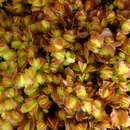ar
الأسماء في صفحات التنقل


Mylia ist eine Moosgattung der Ordnung Jungermanniales. Sie bildet alleine die Familie Myliaceae. Der Gattungsname ehrt den deutsch-holländischen Arzt und Dichter Wilhelm Mylius (1674–1748).[1]
Die Pflanzen haben rundliche bis verlängerte Flankenblätter. Die Unterblätter sind lanzettlich. Sie bilden ovale Brutkörper. Die Laminazellen der Flankenblätter weisen in den Ecken Verdickungen auf. Die Ölkörper in den Zellen sind groß und setzen sich aus kleinen Öltröpfchen zusammen.
Mylia ist die einzige Gattung der Familie Myliaceae und wird in die Ordnung Jungermanniales gestellt.[2] In Europa ist sie mit zwei Arten vertreten, die auch in Deutschland vorkommen:
Mylia ist eine Moosgattung der Ordnung Jungermanniales. Sie bildet alleine die Familie Myliaceae. Der Gattungsname ehrt den deutsch-holländischen Arzt und Dichter Wilhelm Mylius (1674–1748).
Mylia is a genus of liverworts.[1] It is the only genus in the family Myliaceae. While many species are green, some species may be brownish to reddish. The leaves are unlobed and have a smooth edge; the underleaves are tapered and narrow. Plants may have gemmae.
The species of this genus are found in Northern Hemisphere.[1]
Species:[1]
Mylia is a genus of liverworts. It is the only genus in the family Myliaceae. While many species are green, some species may be brownish to reddish. The leaves are unlobed and have a smooth edge; the underleaves are tapered and narrow. Plants may have gemmae.
The species of this genus are found in Northern Hemisphere.
Species:
Mylia aequata (Hook. & Taylor) Kuhnem. Mylia anomala (Hook.) Gray Mylia fragilis (J.B.Jack & Stephani) S.W.Arnell Mylia iversenii S.W.Arnell Mylia taylorii (Hook.) Gray Mylia verrucosa Lindb. Mylia vietnamica Bakalin & VilnetNäivesammalet (Mylia) on maksasammalsuku, johon kuuluu kaksi Suomessa esiintyvää lajia.[2][3]
Näivesammalet (Mylia) on maksasammalsuku, johon kuuluu kaksi Suomessa esiintyvää lajia.
Mylia anomala – rahkanäivesammal Mylia taylorii – kallionäivesammal